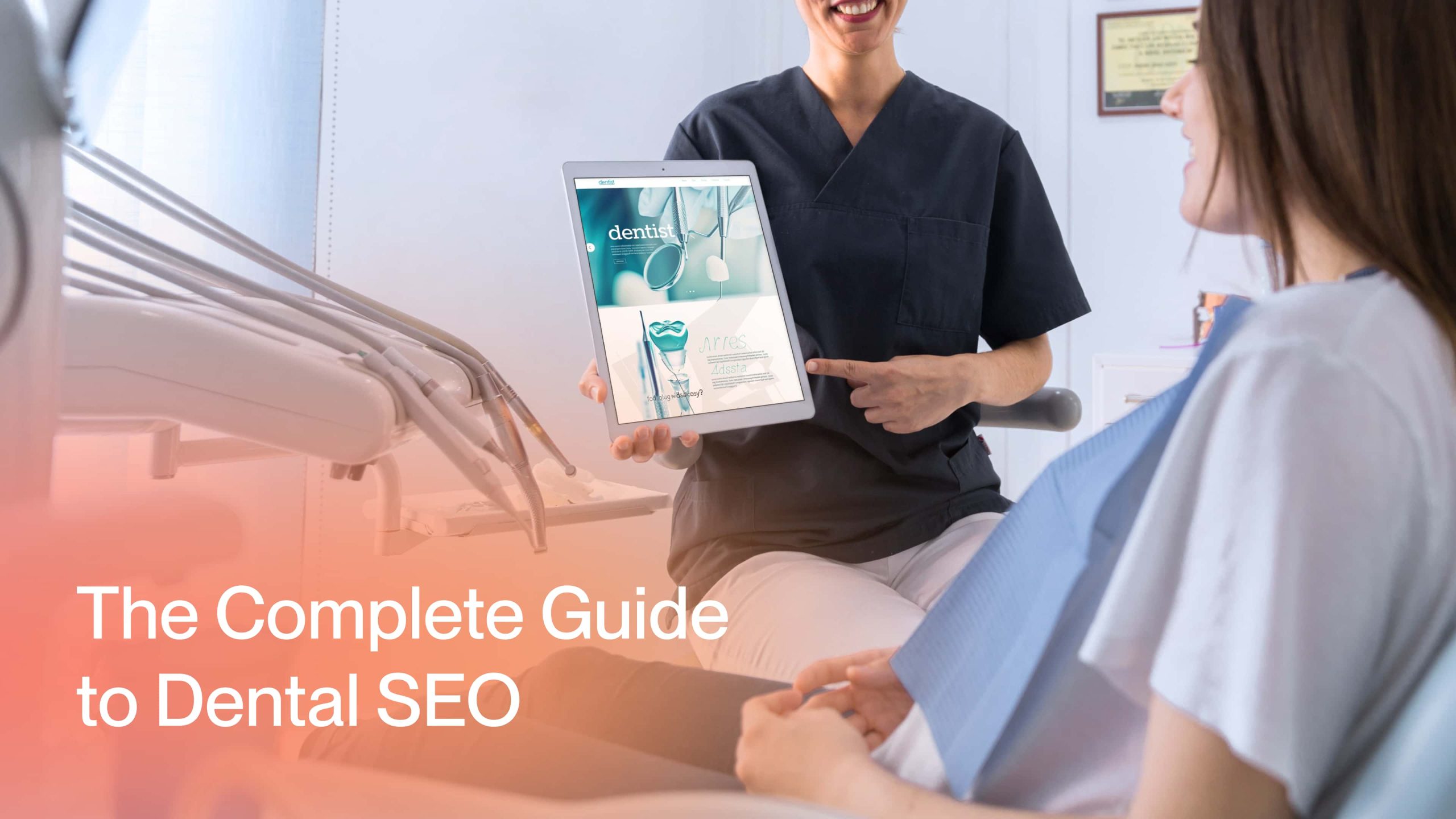If your practice isn’t showing up on Google’s first page, your competitors are getting the calls that should be coming to you.
Done right, dental SEO can improve your visibility in search engines. And even in AI tools.
So when someone searches for “dentist near me” or “teeth cleaning in [city],” your practice shows up.
In this guide, you’ll find 10 actionable SEO marketing for dentists tactics to improve your search engine visibility, attract visitors to your site/clinic, and even turn site visitors into patients.
What Is Dental SEO?
Dental SEO is the practice of improving a dental clinic’s visibility on search engines. Done right, it can increase your clinic’s online visibility and drive more patients to your site and/or clinic.
Suppose you run a dental office in Boston.
You might want to appear when potential patients Google terms like “Boston family dentist” or “root canal specialist Boston.”

You might also want your site to show up for searches such as “benefits of dental implants” or “how often should I get teeth cleaning.”

Also, AI answers for questions like “What are the best dental clinics in Boston?”

Dental SEO makes it happen. And that’s why SEO is important.
Some great SEO strategies for dentists include:
- Finding and targeting keywords that patients search for and your clinic can realistically rank for
- Improving your site’s technical performance to deliver a great user experience
- Claiming and optimizing your Google Business Profile (GBP)
- Getting listed in relevant online local directories to strengthen your presence in local search
- Structuring your content for AI retrieval
And more.
It’s a broad healthcare digital marketing strategy that blends different SEO for dentists tactics.
Together, these tactics can position your clinic as an authoritative source of dental care. And signal to search engines that your site deserves to rank higher in results.
Vadzim Z., Head of SEO at Ninja Promo sums it up nicely:
“Dentists often believe that SEO for dental practices is a one-time task, and it’s enough to have a beautiful website to consistently generate SEO leads. In fact, dental SEO is a complex, multi-layered, and long-term process that includes content, local promotion, technical dental search engine optimization, and reputation management. In addition, medical websites are subject to stricter search engine requirements. Which makes SEO for dentists even harder”
How Dental SEO Differs From General SEO
Dental website SEO has unique characteristics that set it apart from general SEO:
- Local focus: Dental SEO is location-driven. Patients usually search for dentists near them, so ranking in local packs, maps, and city-specific keywords matters far more than global visibility.
- Sales cycle: It’s typically shorter. Patients searching for services like “emergency dentist near me” or “tooth extraction [city]” are ready to book quickly.
- Google Business Profile (GBP) Priority: Since GBP is often the first thing patients see in search results, optimizing it is a top priority.
- Compliance and Content Sensitivity – Google applies stricter standards for healthcare sites through signals like E-E-A-T (Experience, Expertise, Authoritativeness, Trustworthiness) and its “Your Money or Your Life” (YMYL) framework.
- Medical expertise requirements: Dental websites need to demonstrate subject-matter expertise. This often means including author credentials, citing peer-reviewed sources, linking to clinical studies, and highlighting professional affiliations.
- Patient Privacy Considerations: Dental SEO also has to account for HIPAA compliance in the U.S. and equivalent regulations elsewhere.
And these are some big reasons why SEO for dental practices is tougher.
Vadzim Z., Head of SEO at Ninja Promo, explains:
“Google has particularly strict requirements for websites related to health and medicine (YMYL – Your Money or Your Life), evaluating them from the point of view of E-E–A-T factors. For such resources, it is critical to provide accurate, verified and timely information based on clinical data and recommendations from recognized medical organizations. Sites with unreliable, misleading or incomplete content risk not only to lose search results but also to be sanctioned by Google, including quality filters or being completely excluded from the index.”
Why SEO Is Crucial for Dental Clinics
Most patients begin their journey online.
When someone wakes up with a toothache or starts planning for an implant, the first instinct is to Google it up.

In fact, 92% of people aged 18–34 research new healthcare providers online.
And that habit doesn’t disappear with age. Even 73% of patients over 55 turn to search before booking.
And when they do, they rarely go past the first page.
According to BrightLocal, just 0.63% of users ever click to page two.
That means if your practice isn’t visible at the top, your competitors are taking those calls instead of you.
Local intent makes this even more important.
Every month, Google sees more than 1.5 billion “near me” searches, and eight in ten consumers search for local businesses weekly.

SEO is what connects your clinic to those ready-to-book patients at the exact moment they’re searching.
Which is why SEO is important for dental clinics.
How Search Engines Rank Dental Websites
Dental websites fall under Google’s YMYL category. Meaning they are judged by much stricter SEO for dental practices standards than general business sites.
The Search Quality Evaluator Guidelines highlight that medical and dental content is only considered “high quality” when it demonstrates strong E-E-A-T.
Here’s how those signals apply to dental SEO:
1. Expertise and Credentials
Google favors content written or reviewed by licensed professionals.
Dental websites must showcase the qualifications of authors (e.g., DDS, DMD) and cite reputable + peer-reviewed medical sources.
For example, we just love Ask the Dentist’s blog by Mark Burhenne, DDS:

Pages without clear expertise are likely to be judged as “low E-E-A-T” and can lose rankings.
2. Accuracy and Evidence-Based Content
Health information must align with established clinical consensus.
Google raters are instructed to downrank content that contains misleading or incomplete medical advice.
This post on Ask the Dentist blog is a great example:

For dentists, this means procedure explanations, treatment benefits, and oral care advice must be evidence-based and regularly updated.
3. Reputation
A dental site linked to credible institutions (universities, hospitals, and dental associations) is considered more trustworthy.
For example, Dr. Mark Burhenne strengthens his credibility by displaying his membership in the Academy of General Dentistry on his blog.

4. Trust and Safety Signals
Because dental sites influence health decisions, privacy compliance (such as HIPAA), secure browsing (HTTPS), and transparent contact information all affect trustworthiness.
For instance, the Ask the Dentist blog runs on HTTPS.

The site also links to Mark’s active social media profiles.

Pages missing such trust factors risk being labeled untrustworthy.
5. Content Quality and Effort
Google raters look for effort, originality, and depth in YMYL content.
A thin FAQ page about “root canals” won’t carry the same weight as a comprehensive medically reviewed guide.
Again, Ask the Dentist blog is a perfect example.


6. Local Relevance
Beyond medical E-E-A-T, SEO for dentists also relies on local signals.
This includes:
- Optimized Google Business Profiles
- Consistent NAP (Name, Address, Phone) across directories
- Local backlinks
- Solid social media presence
This shows search engines that the clinic is a legitimate option for patients nearby.
While Dr. Mark Burhenne’s Ask the Dentist doesn’t operate as a local practice with a Google Business Profile, he has a solid online presence. With:
- ~3,000 LinkedIn followers
- 850,000+ Instagram followers
- And more than 50,000 YouTube subscribers

How to Build an Effective Dental SEO Strategy
An effective dental SEO strategy is a structured plan that aligns your clinic’s goals with how patients search for dental care.
[Request] Can we offer a template or something here to make this really really actionable? If yes, I’d like to request a template from the Graphics team.
Follow these steps to create a powerful SEO strategy:
- Set clear goals: Start with measurable goals. Like more appointment bookings, better visibility for local queries, stronger local map rankings? Use the SMART framework (Specific, Measurable, Achievable, Relevant, Time-bound) to define what success looks like.
- Research your target audience: Specify who your ideal patients are. Think about age, demographics, income level, and dental needs.
- Perform competitor analysis: Look at which clinics consistently rank on the first page for both local and informational intent. Study their websites, service pages, Google Business Profiles, reviews, and backlinks. This will reveal what they’re doing right and where you can outperform them.
- Define your positioning: Decide how your practice should stand out. Your positioning drives your messaging.
- Perform a full-fledged SEO audit: This will help you identify any potential issues that need to be fixed before you double down on your SEO efforts.
- Map tactics to goals: Once the foundation is in place, align specific SEO tactics with your goals. For example, if building awareness is the priority, double down on long-form educational content. If driving conversions is an urgent priority, double down on GBP.
- Track and refine: Make it a habit to track your results so that you can understand what’s working and what’s not. And based on that make data-driven decisions to further refine your SEO strategy.
9 Best Dental SEO Tactics
One of our recent local SEO for dental practices involved promoting a clinic in a large city.
We focused on local dental SEO services, optimized the clinic’s service pages, and strengthened its E-E-A-T factors. Within six months, organic traffic grew by 52%, and the number of online appointment bookings more than doubled.
Based on our experience working with several dental clinics, here are the 10 tactics that deliver the greatest impact for dental clinics:
1. Optimize Your Website for Local Search
Like I said before, local SEO for dentists is heavily location-driven.
Your goal should be to appear in searches such as “dentist near me” or “teeth cleaning in [city].”
Here are some tactics to consider:
- Claim and optimize your GBP
- Use consistent NAP details across local directories
- Create dedicated location pages targeting city- or neighborhood-specific keywords
- Encourage satisfied patients to leave reviews on your GBP and other platforms
Start with your GBP.
This is often the very first thing patients see in local search results and on Google Maps.
Here’s what an optimized dental clinic GBP profile looks like:

You can create or claim your GBP listing on Google Business Profile Manager.

Follow the on-screen instructions to finish the setup process.
Once your GBP is set up, optimize it so that it appears for relevant local queries.
That means:
- Adding primary and secondary categories (e.g., Dentist, Cosmetic Dentist, Emergency Dental Service)
- Writing a clear business description with your specialties and city name
- Uploading high-quality images of your clinic, staff, and treatments
- Enabling features like online booking, messaging, and Q&A
- Actively requesting and responding to patient reviews
A fully optimized GBP profile can also increase your chances of showing up in the Local Pack.

And higher on Google Maps.

2. Perform Keyword Research for Dental Services
It’s the process of identifying the exact terms patients type into Google when they’re looking for dental care.
Patients search differently depending on where they are in their dental health journey, and each stage maps to a different type of search intent:
- Informational intent: Patients looking for answers or education. Example: “why do my gums bleed when brushing” or “how often should I get teeth cleaning.”
- Navigational intent: Patients searching for a specific clinic, dentist, or brand. Example: “Dr. Smith dental clinic reviews” or “Boston Dental Associates website.”
- Transactional/Commercial intent: Patients ready to book or compare services. Example: “emergency dentist near me,” “teeth whitening cost [city],” or “best pediatric dentist Boston.”

Your keyword dental SEO strategy should cover all these stages.
That way, your website captures patients from the moment they begin researching symptoms all the way to booking an appointment.
How to identify these keywords?
Use keyword research tools like Semrush’s Keyword Magic Tool. It has a massive database of over 25 billion keywords which are updated in real-time.
Simply enter a seed keyword such as “dentist Boston” or “dental implants” and you’ll get a full list of related terms patients are actually searching for.

Along with intent and other metrics for each like:
- Volume: How many searches the keyword gets each month
- Trend: Whether interest is growing or declining over time
- KD% (Keyword Difficulty): How competitive the keyword is to rank for

Apply filters to narrow down your search.
For instance, set the intent filter to quickly separate keywords by informational, navigational, or transactional intent.
3. Create Service-Specific Pages
You may be offering different services in your clinic, and each one deserves its own dedicated page.
This can include:
- Dental Implants
- Root Canal Treatment
- Teeth Whitening
- Braces and Orthodontics
- Emergency Dentistry
For example, these are the services offered by Smile Delhi dental clinic.

Vadzim Z., Head of SEO at Ninja Promo shares why service pages are important:
“Most inquiries typically come from detailed service pages and local pages, as these tend to capture users with transactional intent.”
While researching keywords, you might have already identified treatment-specific terms patients use.
These keywords should guide the creation of your service pages.
For instance, Smile Delhi’s dental implant page targets the primary keyword “dental implant.” And it has been used 22 times throughout the page.

Each page should:
- Target one main keyword and related long-tail terms
- Explain the procedure clearly, including benefits and recovery details
- Answer common patient questions
- Add location-specific modifiers so the page ranks in your city or neighborhood
- End with a clear call-to-action to book an appointment
You can also create multiple location pages for the same service if your clinic operates in different areas. For example, “Dental Implants in Delhi” and “Dental Implants in Mumbai.”
4. Create High-Quality Educational Content
Not all dental searches have a location intent. Or a commercial intent.
Many patients start with informational queries:
- “How long do dental implants last?”
- “Why do my gums bleed when brushing?”
Keyword targeting can increase your clinic’s reach. And build trust.
Just make sure your content is accurate and not misleading. SEO for dentists comes with stricter standards, and publishing incorrect or low-quality advice can have long-term consequences.
Olivia G., SEO Specialist at Ninja Promo, explains:
“Yes, we have encountered such cases after clients attempted dental SEO themselves with poor quality or after projects were handled by unprofessional teams. Search engines take misinformation in the medical field very seriously, and a website can be penalized and struggle to recover. Even after correcting the content and having it re-indexed, it may still fail to appear in search results. Therefore, it’s best to follow a reliable dental SEO strategy from the very beginning.”
A strong example of high-quality educational content is Ask the Dentist.

Dr. Mark Burhenne publishes long-form educational articles that answer common dental questions in detail.
And since dental websites SEO fall under Google’s YMYL category, make sure your content is:
- Accurate and evidence-based
- Accessible (use simple language)
- Engaging
- Patient-centered
5. Implement On-Page Dental SEO Best Practices
On-page SEO is the practice of optimizing webpages and their content for both users and search engines.
This includes optimizing:
Title Tags
It’s the clickable headline that appears in search results and browser tabs. It can directly influence your search engine rankings and click-through rates.

Meta Descriptions
It’s a short summary that appears under the title tag in search results. It doesn’t impact rankings but it can convince users to click on your page.

Alt Text
It’s the text you add to describe images on your site. Because search engines can’t read images, it helps them understand visuals. It also improves accessibility for visually impaired users.

Headers (H1, H2, H3)
These are headings that structure your page content. They can help you organize information so both search engines and users can better understand it.

Internal Linking
These are links that connect one page of your site to another. Internal links guide patients to related content and also pass authority between pages, which can improve search engine rankings.

And more.
6. Focus on E-E-A-T (Experience, Expertise, Authoritativeness, Trustworthiness)
As previously discussed, dental sites fall under Google’s YMYL category. Which is why E-E-A-T signals carry extra weight.
In fact, E-E-A-T is one of core SEO principles today.
You need to prove to both search engines and patients that your clinic is credible, safe, and medically reliable.
Here’s how to do it:
Showcase Professional Credentials
Add author bios with degrees (DDS, DMD) and years of clinical practice. If articles are reviewed by a licensed dentist, make that clear.

Cite Authoritative Sources
Link to authoritative sources like peer-reviewed studies, ADA guidelines, or respected dental journals.

Highlight Affiliations and Awards
Strengthen credibility by displaying affiliations like the Academy of General Dentistry or the American Dental Association. Like this:

Write From Your Experience
Search engines (and even AI tools) value first-hand expertise. That’s the “E” behind Experience in E-E-A-T.
So, it’s a good idea to share real patient scenarios (with consent), explain procedures you perform daily, or add personal commentary on treatment options.

7. Improve Your Site’s Technical SEO
Technical SEO is the process of improving the technical elements of your site so that search engines can find, understand, and store your content. And visitors enjoy the overall user experience.
For example, if your site isn’t crawlable, search engine crawlers won’t find it.

Start with a full site SEO audit.
Wondering why? Read this resource to understand the importance of SEO audit.
Here are a few technical SEO strategists for dentists to prioritize:
- Make sure your site is mobile-friendly
- Implement HTTPS, and fix any HTTPS issues if they exist
- Improve Core Web Vitals
- Fix crawlability and indexing issues
- Fix broken links
- Use clear URL structures
And more.
The goal is to build a solid technical foundation so that your other healthcare SEO efforts can drive outstanding results.

8. Collect and Showcase Patient Reviews
63.6% of consumers have claimed that they are likely to check Google reviews before visiting a business location.
Google treats patient reviews as a strong trust signal, especially in local dental SEO. In fact, reviews are highlighted in Google’s own documentation as a key factor that directly influences local ranking.

And in dentistry, this is even more important.
Here’s how to collect customer and showcase reviews:
- Encourage patients to leave reviews: After an appointment, send a follow-up email or SMS with a direct link to your GBP.
- Respond to every review: Whether positive or negative, respond to every customer review. This will help you show that you value patient feedback and take their experience seriously.
- Highlight reviews on your website: Add a testimonials section or embed Google reviews directly on your site’s important pages.
- Diversify platforms: Collect reviews on healthcare-specific sites like Healthgrades, Zocdoc, or Yelp to strengthen your overall online reputation.
- Handle negative reviews professionally: No matter how critical or unfair a review may seem, avoid reacting defensively.
Look how this NY-based clinic handles customer reviews:

9. Build High-Quality Backlinks from Dental & Health Sites
Backlinks are links from one site that point to another. Search engines treat them like votes of confidence.
The more high-quality sites that link to yours, the more credible your clinic seems. This can improve your search engine rankings.

For dental sites, backlinks from hospitals, universities, dental associations, and trusted local organizations matter a lot. These links show both Google and potential patients that your practice is part of a verified medical community.
A backlink from a local hospital carries far more weight than one from an unrelated blog.
Olivia G., SEO Specialist at Ninja Promo, explains:
“In dental SEO, the most valuable backlinks come from authoritative sources. These include reputable medical directories, professional dental associations, educational institutions, and well-established health websites. Links from such sources signal trustworthiness and expertise to search engines.”
Here are some great local link building strategies:
- Join professional organizations like the ADA, which often list members in public directories
- Contribute expert articles to dental or healthcare publications
- Partner with local schools, charities, or health events and request a mention on their websites
- Publish data-backed research and case studies that other sites naturally want to reference
High-quality backlinks take time to earn, but even a small number from authoritative medical and local sources can drive real results.
Want More Patients Visiting Your Clinic? Looking to Grow Your Practice?
Every time your clinic doesn’t appear, you lose a potential customer.
We’ve helped different kinds of dental clinics across multiple locations improve their dental practice’s online presence with our strategic 360-degree dental SEO experience—from pediatric dentists to orthodontists.
Our team understands the healthcare SEO space inside out. And we’d love to help your clinic get more calls and bookings.










